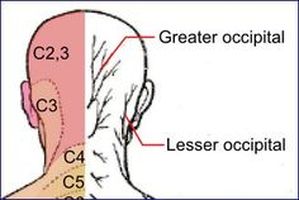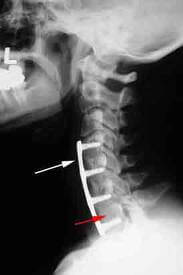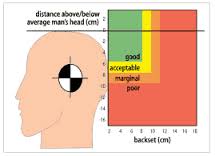First of all, this is a bit of a misleading title because the first step in analysis is to check newborns for a misalignment. While the likelihood of a misalignment is very high after a newborn undergoes the delivery process, it remains possible that the newborn is aligned perfectly and would therefore not need to be adjusted.
Whether a baby is delivered vaginally or via C-section, there is a tremendous amount of torque placed on the infant’s head/neck area when entering the world from the womb. When interventions used to assist delivery such as vacuum or forceps are needed, the likelihood of a misalignment increases even more.
Therefore, there is a very high likelihood that the head/neck area is misaligned in a newborn following delivery, and this misalignment can create many detrimental health problems. Here are the benefits for detecting and correcting a misalignment as soon as possible:
1. Improves Brain & Nervous System function
The developing brain of the human being relies heavily on sensory input from the body via the spinal cord. A misalignment at the ‘fuse box’ area can interfere with the brain-to-body communication, thus impeding the function of the nervous system and slowing brain development.
2. Helps Bones grow in alignment
The bones of a newborn are cartilaginous. They do not fully ossify (turn into bone) until the teenage years. If there is an undetected misalignment from delivery, the bones in the spine can grow asymmetrically and this can create imbalances throughout the entire body as it continues to form. Just like building a house first requires a level foundation, a spine requires alignment from the beginning in order to grow and develop properly.
3. It decreases likelihood of Scoliosis & Torticollis
Scoliosis is a lateral curvature in the spine that often continues to progress in adolescence and can potentially compromise the function of various organs of the body. A high percentage of scoliosis cases are caused as a compensation for misshaped vertebra in the spine. Balance in the spinal vertebra can dramatically decrease the chance of developing scoliosis.
Torticollis is a spasm of the neck musculature on one side of the body. This pulls the head/neck in one direction and creates pain and dysfunction in the newborn. Proper alignment can set balance to the muscles and prevent or correct torticollis.
~Noah Kaplan, D.C.
References:
http://www.chirotips.com/infants_need_chiropractic_care.htm
http://welladjustedbabies.com/why-parents-take-children-to-chiropractors
Occipital Neuralgia Helped by Upper Cervical Care
Reply

Occipital Neuralgia is one of the most common diseases that people frequently confuse with migraines and other types of severe headaches due to the fact that THE SYMPTOMS ARE VERY SIMILAR! Occipital Neuralgia is a neurological disease that occurs due to the inflammation and irritation of the nerves exiting from the top of your spinal cord through the top of your neck, and back up through the scalp.
Occipital Neuralgia stated simply is nerve pain that originates from the back of the head also called the occiput that radiates out along the path of the nerves.
If you have been diagnosed with Occipital Neuralgia or are experiencing pain in the back of your head or upper neck area or even if you suffer from headaches, read on and maybe this will give you an idea of what might be causing your problem.
Symptoms of Occipital Neuralgia?
Occipital Neuralgia can cause a really sharp stinging feeling which is accompanied by an intense sharp pain at the back of the head and the neck. Common symptoms for Occipital Neuralgia include:
- Pain when moving your neck
- An unusually tender scalp
- Pain behind either one of your eyes
- Heightened sensitivity to light
- Throbbing pain that gradually starts at the base of the head and radiates to the scalp
Please note: doesn’t this sound an awful lot like a migraine headache?
- Pain when moving your neck
- An unusually tender scalp
- Pain behind either one of your eyes
- Heightened sensitivity to light
- Throbbing pain that gradually starts at the base of the head and radiates to the scalp
Please note: doesn’t this sound an awful lot like a migraine headache?
Injuries to The Neck and Occipital Neuralgia

An injury to the neck due to some sort of accident such as: a car wreck, sports injury (especially with concussion), a hard fall etc. is very likely to tear loose the connective tissues that hold your spine together allowing the upper neck to misalign. To make a long story short, months or even years later you are likely to develop symptoms or even worse Occipital Neuralgia. The reason being that injuries to the neck very commonly result in the misalignment of one of the two top neck bones, commonly known as Atlas or Axis; this leads to irritation and pressure in and around the brain stem, and upper spinal cord, which is the connection between the brain and the body.
The brain stem ends where the spinal cord begins, and the spinal cord is literally a bunch of nerves that tell the body what to do. Every signal is emitted from the brain stem as the master control center of the body and the spinal cord nerves are just used as a channel to convey the signals throughout the body.
A misalignment in the upper neck affects you in two ways. First, your brain is unable to communicate with the rest of your body adequately, and secondly, a misalignment in the upper neck alters your center of gravity. When your head goes off-center, your spine creates abnormal curvatures below to compensate, and this results in the loss of normal spinal curves over time. This relates to the spinal cord in that; if you lose your normal spinal curves, then you lose the extra slack in the spinal canal and your nerves exiting along the spine can end up being under tension in certain areas of the spine, much like tightening a guitar string. Your unique spinal anatomy will dictate where that tension ends up.
The 3 most common spinal compensation areas that come under high stress in the human spinal column are:
1. The upper neck
2. The lower neck, upper back and shoulder area
3. The lower back and hip area
Over time these high stress areas will become inflamed, symptoms will develop, and the spine will start to degenerate. Please note that what you may see in any anatomy textbook only occurs 30% of the time at best meaning 70% of the time spinal structures are highly variable, and especially cranial nerves and spinal nerves. Spinal nerves can begin and end in many different variations.
With Occipital Neuralgia there are 3 nerves we need to consider:
1. The suboccipital nerve – originates between Atlas or C1 and the Occiput.
2. The greater occipital nerve – originates between Atlas and Axis or C1 and C2.
3. The lesser occipital nerve – originates between Axis or C2 and C3.
Is it possible that an old injury to the neck has resulted in spinal misalignment and over the months and years since then the chronic irritation to one or all of the occipital nerves has resulted in pain in the back of your head that now radiates?
The brain stem ends where the spinal cord begins, and the spinal cord is literally a bunch of nerves that tell the body what to do. Every signal is emitted from the brain stem as the master control center of the body and the spinal cord nerves are just used as a channel to convey the signals throughout the body.
A misalignment in the upper neck affects you in two ways. First, your brain is unable to communicate with the rest of your body adequately, and secondly, a misalignment in the upper neck alters your center of gravity. When your head goes off-center, your spine creates abnormal curvatures below to compensate, and this results in the loss of normal spinal curves over time. This relates to the spinal cord in that; if you lose your normal spinal curves, then you lose the extra slack in the spinal canal and your nerves exiting along the spine can end up being under tension in certain areas of the spine, much like tightening a guitar string. Your unique spinal anatomy will dictate where that tension ends up.
The 3 most common spinal compensation areas that come under high stress in the human spinal column are:
1. The upper neck
2. The lower neck, upper back and shoulder area
3. The lower back and hip area
Over time these high stress areas will become inflamed, symptoms will develop, and the spine will start to degenerate. Please note that what you may see in any anatomy textbook only occurs 30% of the time at best meaning 70% of the time spinal structures are highly variable, and especially cranial nerves and spinal nerves. Spinal nerves can begin and end in many different variations.
With Occipital Neuralgia there are 3 nerves we need to consider:
1. The suboccipital nerve – originates between Atlas or C1 and the Occiput.
2. The greater occipital nerve – originates between Atlas and Axis or C1 and C2.
3. The lesser occipital nerve – originates between Axis or C2 and C3.
Is it possible that an old injury to the neck has resulted in spinal misalignment and over the months and years since then the chronic irritation to one or all of the occipital nerves has resulted in pain in the back of your head that now radiates?
Upper Cervical Chiropractic Care In Boise, Idaho
If you have been experiencing Occipital Neuralgia, it would be a good idea to look into Upper Cervical Chiropractic care and if you live in Boise, Idaho we offer a free consultation to determine if Upper Cervical Chiropractic care is right for you.
If you have already gone the medical route hopefully you have come to the conclusion that just covering up your symptoms with injections or medications will NEVER fix a spinal structural problem.
Upper Cervical Chiropractic care is designed to reposition your head and neck in the proper alignment so that the stress on your joints and muscles is removed and as the spinal structures begin to heal themselves, symptoms will start to fade away. Specialized x-rays are taken to determine the nature and quality of the misalignment. Infrared thermography is used to document irritation and interference throughout the neck. Then the spinal correction is given using a precision touch to correct it.
If you are experiencing occipital neuralgia, don’t wait! Call an Upper Cervical doctor for a Complimentary Consultation to discuss your health concerns and determine if Upper Cervical care is right for you.
If you have already gone the medical route hopefully you have come to the conclusion that just covering up your symptoms with injections or medications will NEVER fix a spinal structural problem.
Upper Cervical Chiropractic care is designed to reposition your head and neck in the proper alignment so that the stress on your joints and muscles is removed and as the spinal structures begin to heal themselves, symptoms will start to fade away. Specialized x-rays are taken to determine the nature and quality of the misalignment. Infrared thermography is used to document irritation and interference throughout the neck. Then the spinal correction is given using a precision touch to correct it.
If you are experiencing occipital neuralgia, don’t wait! Call an Upper Cervical doctor for a Complimentary Consultation to discuss your health concerns and determine if Upper Cervical care is right for you.
~Dr. Grayson Blom
All About Stress

The number one stress on your body is not traffic, family or your job. Most people don’t recognize this stress because it is constant, beginning with our first breath outside the womb. Without this stress our bodies would be weak, our bones brittle. You probably have guessed that the stress that I am talking about is gravity. Astronauts that return from space have a seven to ten day recovery period because of their time in zero gravity. In just that short amount of time without gravity, astronauts lose calcium from their bones and mass from their muscles and equilibrium. All of this to say, without stress our bodies would be weak. Stress is not our enemy and in most cases stress even makes us stronger.
Let’s use running as an example. The physical stress from running forces the heart to work harder. Your body, through a process called anastomosis, responds by creating more blood vessels around the heart so that it can be supplied with more oxygen. Without the stress from the cardiovascular workout there would be no need for a more complex network of blood vessels around the heart. So which heart is healthier? Is it the one with more oxygen supply or the one with fewer blood vessels? When our body is functioning properly it can meet the demands placed upon it.
It would make sense then to focus on not stress itself but our body’s ability to adapt to stress. What can we do to help our body adapt to stress?
- Get a good night’s rest. ( Allows your body to recharge)
- Eat nutritious foods. (Gives your body needed building blocks to recover from stress)
- Drink lots of water. (It is the key component in many of our bodily functions)
- Make sure your nervous system is functioning properly.
By keeping the nervous system healthy, you don’t need to be stressed about stress.
~Dr. Kevin Lin
http://precisionchirofl.com
What If I’ve Had Surgery Already?

When it comes to severe neck and back pain, many people are desperate to find a way to make the pain stop. Concerns about the severity of the pain, along with the potential thought that they can lose function in their arms and legs lead people down the path of having a spinal surgery.
Who can blame them? When you are dealing with a pain so bad, the comfort of your own bed is the only time you feel relief, then surgery really feels like the only option that you have. Many patients will get surgery on their neck and their back in hopes that they will have permanent resolution of their pain.
While some lucky patients may get full resolution of their pain, many people will find their pain returns within a few months or experience a new pain following a surgery like a spinal fusion. This is often classified as a condition called “failed back surgery syndrome”, which is a true code-able diagnosis. Following a surgery like this, patients who are still in pain often go down a road of pain management, and can become addicted to powerful narcotics like oxycontin and Percocet. Others will seek out more natural methods like acupuncture.
Many patients after a spinal fusion are reluctant to have a chiropractor touch their spine. After all, who would want someone twisting or popping a spine that has plates and screws attached to it?
Fortunately, for these types of patients there is a better option. One of the reasons that orthopedic surgeons and neurosurgeons refer patients to my office is because I practice a form of chiropractic that focuses on correction of the Atlas. While many chiropractors rely on manipulation of all of the spinal joints to help the patient get relief, my office uses a very gentle and precise correction procedure that eliminates any popping, twisting, or cracking of the spine.
The truth is, we can’t alter (nor want to alter) parts of the spine that are surgically fused. However, that doesn’t mean that we can’t improve the lives of these patients. Many of the patients who continue to suffer after a surgery usually have a problem processing pain signals into the brain. Often times, the processing of pain is related to malpositioning of the head and neck. When the head and neck shift out of place, then signals from the spinal cord going into the brain get scrambled and misinterpreted. This usually results in the body being more sensitive to pain than it should.
When we correct the positioning of the head and neck, the brain is able to re-establish normal circulation and the tension on the spinal cord become reduced. This allows for more efficient processing and communication between the brain and the rest of the body. The truth is, when the brain is talking to the body better, the body is able to deal with the problematic tissues that are creating those chronic pain signals through plasticity and neurological re-wiring.
The best part of all, is that we don’t have to tinker with a part of the spine that is fused and locked in place. Unless the head has been surgically fused to the neck, there’s a good chance that the answer to your chronic pain may just be as simple as getting your head on straight again.
~Dr. Jonathan Chung, D.C.
Keystone Chiropractic
www.chiropractorwellington.com
Breaking Chronic Pain Cycle of Fibromyalgia

Chronic pain takes many shapes and forms, but we know that it has a huge social and economic burden. The Institute of Medicine reports that roughly 116 million, or 30% of the population suffer from pain lasting a year or longer. Although chronic pain isn’t a life threatening issue, it’s certainly a problem that has a dramatic effect on the quality of someone’s life. After taking care of hundreds of people with conditions like fibromyalgia, I know that these people experience quite a toll both physically and emotionally.
Perhaps the worst part about fibromyalgia is that there is no known cause or cure. It’s basically invisible to any blood tests or MRI studies, and most of the drugs available are for pain control. People with fibromyalgia may often be depressed, have anxiety, and have a sense of isolation because they don’t feel that their friends and family understand their struggle. This often compounded by the fact that their doctors have told them that the pain is psychosomatic, or just in their minds because no tests can reveal an underlying disease process.
In recent years, fibromyalgia has become one of the most published topics in medical journals. As a result, we are starting to develop an understanding of the disease on a deeper level to know that it’s certainly NOT just in the patient’s mind. Research is pointing to problems within the central nervous system and tiny blood vessels in the skin as likely causes of the deep body-wide pain. But what does this mean in terms of treatment.
For most people, drugs that target the nervous system like Lyrica or Gabapentin are the first line of treatment and many have had success. However, some patients can be sensitive to drug reactions, or their bodies may develop a high tolerance for the dosages. In cases like these, many patients start to seek out alternative therapies like acupuncture, reiki, and homeopathy.
Traditional chiropractic has also been a source of relief for many people seeking help with chronic pain. However, many people with the chronic pain of fibromyalgia can feel apprehensive about seeing a Doctor of Chiropractic because manipulations can seem too rough for someone who can barely stand to be touched.
Not All Adjustments are Built the Same
In chiropractic, there are dozens of techniques and approaches to correcting the spine. Some are heavy handed and require a lot of force, but others are very gentle and rely more on precision. It’s not to say that one is better than the other, but some are just designed for specific patient populations in mind.
In my office, I attract many patients with fibromyalgia, trigeminal neuralgia, and TMJ problems that are Secondary to a Structrual problem in the neck called Atlas Subluxation Complex. Most of these people are afraid to be touched, and gravitate to a lighter approach. This type of condition requires a precision type of adjustment called an Atlas Correction. This type of adjustment is so light, that most people often wonder if I even touched them, and then they start to feel their body change. Currently, only about 1000 doctors in the country are trained in this type of care.
This approach is effective because of the spine’s influence on the central nervous system. When the top of the neck shifts abnormally and moves improperly, the nerves firing into the brainstem become distorted. In this way, the brain is like a computer that relies on spinal positioning to operate normally. When there are garbage signals going into the brain, then garbage signals come out in the form of pain. This phenomenon in fibromyalgia patients creates a condition called central sensitization. This is the reason why people with fibromyalgia can feel excruciating pain from a light touch. It’s not that there’s a physical injury, but the nervous system is getting scrambled signals and is primed to experience pain.
This is NOT designed to cure you. The cure lies in the fact that the body is capable of healing itself. When you remove interference to the body’s self-healing ability, I find that people can return to a level where life is livable again. By breaking the pain cycle through the nervous system, you can impact the way stress affects the body and the immune system. By no means is this a cure all, but it can be a great catalyst to being steered back on the path towards a normal life. I’ve seen numerous patients who’ve been able to go from disability to working or resuming exercise again in a matter of months.
One of the greatest joys of doing this type of work is giving people a glimmer of hope. So many people are convinced that they have to live in pain, or have been told that the problem they’re having is all in their head. In my office, I’ve helped hundreds of people recover from chronic pain with this gentle procedure. However, it’s not for everyone. Only people with a problem in their Atlas can receive this type of care, and that requires a detailed Upper Cervical Chiropractic Examination to identify the problem. Sometimes a little bit of hope is all a person needs to start healing again.
~Dr. Jon Chung
www.chiropractorwellington.com
Migraines: Treat with Drugs or Naturally?

Got Migraines?
If you are prone to migraines, then you can probably feel one coming on, long before it actually arrives. These headaches can be debilitating and almost impossible to get over. You become nauseous and any type of light hurts not only your eyes, but splits your head wide open. In the past, the only thing you could do was drug yourself with some form of headache medicine and retreat to a cool dark room. You could only hope that no one would make a sound until the pain started to subside, even then you would be groggy for days after the headache was over, and in constant wonder as to when it would strike again. In recent years, many people have turned to Upper Cervical Chiropractors to find the cause that relieves the stress and tension associated with migraines and the pain that they bring.
Is The Modern Method of Drugging Yourself A Good Idea?
Of course, the modern method of drugging yourself until the migraine passes were much better than the remedy used 3,000 years ago, when they drilled a hole in your head to relieve the pressure. However, it has now been discovered that Upper Cervical Chiropractic specialists have the magic touch that can help the millions of sufferers in the world today.
Migraines come from neck injuries such as car accidents, sports injuries, or even a slip or fall. Migraine headaches most commonly come from a fluid imbalance in the brain. It is known that a spinal misalignment in the neck can interfere with how blood flows in and out of the brain thus causing migraine’s. Can a drug fix this?
There are plenty of drugs that combat migraines and plenty of doctors out there that will prescribe them for you to help get rid of the pain. There are plenty of studies, however, showing time and time again that Upper Cervical Chiropractic care is safe and highly effective treatment for migraine headaches, compared with traditional medicine which is based only on covering up your symptoms rather than finding the cause. To be completely frank medicine is designed only to keep them at bay.
How Do You Fix Migraine Headaches Naturally?
Upper Cervical Chiropractors have demonstrated that migraines start in the spine and likewise correction of the spinal problem (the cause) results in restoration of health. A paper published in JVSR demonstrating over 100 cases getting well via Upper Cervical Chiropractic care. Is it better to fix the cause of a problem or just cover up the symptoms?
Migraines have been around for centuries, long before there was any type of medicine around to cover up the symptoms. If you suffer from migraines and you have realized that traditional medicine just isn’t worth the risk, we would recommend you schedule a consultation with our office to see if Upper Cervical care can help you. Wouldn’t you rather find and fix the cause of the problem?
Upper Cervical care is a specialty meaning there are very few Doctors trained and certified to do Upper Cervical work. Finding one can be difficult.
Dr. Grayson Blom
www.uppercervicalclinicsofidaho.com
Good vs. Bad Exercise

Almost all of my practice members ask me what type of exercise they should be doing and what things they should avoid. This is such important information because doing the correct things between visits can help support your body’s ideal position and retrain the muscles and ligaments surrounding the spine to move properly. This leads to improved function and performance, and ultimately helps the body hold the correction for longer periods of time. On the other hand, doing the incorrect exercises can throw the body out of alignment and/or perpetuate a misaligned spinal pattern that can lead to pain, inflammation, imbalance, and dysfunction.
Good Exercise
Functional movements that support normal biomechanical motion such as:
- Walking
- Running (30 minutes or less)
- Yoga
- Pilates
- Functional Exercise classes such as Crossfit, Bar Method, etc.
- Pull-ups
- Push-ups
- Lunges
- Squats
- Planks
- Presses
- Stretching properly
Abnormal movements that put improper pressure on the head, neck, and spine such as:
- Headstands
- Bridges (with weight on head)
- Sit-ups/crunches
- Weight machines
- Excess cardiovascular workouts (over 30 minutes)
~Noah Kaplan, D.C.
What is the Proper Headrest Position for your Car Seat?

The truth is that there is a proper position for the headrest that can increase your safety when riding in a car. The problem is that most people (including car dealers) don’t know what this position is, and therefore people are not properly fitted to their headrests when purchasing a new car. Before I get into the recommendations, let’s understand what happens to the body in a car accident:
In the United States, 30% of 6 million police reported vehicle crashes are rear-end collisions1. The most common symptom of whiplash or whiplash associated disorders (WAD) is pain due to mild muscle strain or mild tearing of soft tissue. Other injuries include nerve damage or damage to the intervertebral disc(2).
There is evidence that the risk of injury in rear-end collisions is independent of vehicle damage. In fact, little or no crush damage to a vehicle can result in injury with or without immediate symptoms like neck pain, headaches, back pain, etc. It has also been shown that if there is little or no movement of the head relative to the torso in a collision, people may escape neck injury even in severe crashes(2).
In a rear end collision, the head rises above the head restraint and there is a temporary straightening of thoracic (upper back) and cervical (neck) curves upon impact (Figure 1)(1). Head restraints contribute in limiting the neck distortion that occurs before the head starts to follow the torso. Effective head restraints reduce rearward motion of an occupant’s head in a rear-end crash and decrease the likelihood of sustaining a whiplash injury.

Figure 1. Effects of rear-end collision
Recommendations:
A head restraint should be positioned at < 6cm below the top of the head or at least level with the top of the ears. The distance from the back of the head to the restraint should be as small as possible or < 6 cm from the back of the head

~Noah Kaplan, D.C.
via Jeffrey R. Scholten Professional Corp.
Practice of Upper Cervical Chiropractic
www.practiceofuppercervical.com
1. Taylor, JAM, et al. Car seat head restraint. J Can Chiropr Assoc. (2005). 49(1).
2. Insurance Institute for Highway Safety www.iihs.org
Posture: A Window to Health

Posture is a window to spinal alignment and body balance. Our body functions at full capacity when we are in balance. Therefore, structural integrity dictates how our body functions on every level.
Benefits of Good Posture:
- Improves breathing capacity
- Improves brain function
- Improves blood circulation
- Improves digestion
- Decreases stress on spine
- Decreases stress on other joints
- Prevents back pain
- Improves self-image
- Move your spine every day – walking, yoga, pilates, etc.
- Strengthen core muscles
- When sitting: Keep knees, hips, and elbows at 90 degrees and use a low back support.
- When sleeping: Use proper pillows to keep spine neutral
- Take breaks (change positions)
- Chest opening stretches
- Foam rolling for mid-back extension (foam roller is perpendicular to spine)
- Superman exercise (either on hands and knees or supine on ground)
- Seated row exercise with light-moderate weight
For example, a common postural problem in our computer society today is Forward head posture. This position dramatically increases stress on cervical spine and over time leads to degenerative discs, pain, & inflammation. Rounded shoulders can decrease lung capacity. Rotation or tilting of the head can decrease blood flow to the brain.
 Postural distortions are often the result of a misalignment at the keystone level of the spine: the Upper Cervical area at the top of the neck. If this keystone is misaligned, even by a millimeter, it can create a compensation pattern below it.
Postural distortions are often the result of a misalignment at the keystone level of the spine: the Upper Cervical area at the top of the neck. If this keystone is misaligned, even by a millimeter, it can create a compensation pattern below it.An Upper Cervical Chiropractor is the only one who can properly evaluate this and correct it.
~Noah Kaplan, D.C.
Pain in the Neck

It’s no surprise that our culture of sitting in front of a computer increases our chances of suffering from neck pain. Forward head posture and slumped/rounded shoulders create abnormal stress on the cervical spine and increase likelihood for symptoms of pain, headaches, and neurological problems (like tingling/numbness in the arms/hands). However, the postural stress is not usually the cause of the problem itself. The underlying issue is usually a misaligned cervical spine (neck) that is exacerbated by postural stress. The good news is that in most cases this problems is fixable with Upper Cervical Chiropractic care.
Some studies estimate that nearly 90% of people will eventually suffer from neck pain at some point in their life. Interestingly, neck pain is more prevalent in urban environments, especially among office and computer workers. It’s also more common in women and more prevalent in middle age (35-50)
The cause of neck pain is usually a combination between trauma and environmental factors. Trauma can include childhood falls, sports injuries, whiplash, or even a torqueing of the neck from the delivery process at birth. This trauma can cause the spine to misalign and lock into a stressed position. Over time, gravity will cause the spine to degenerate quicker than usual because the weight of the head is not being held up equally by the vertebra of the cervical spine. This degeneration can lead to problems with the joints, muscles, ligaments, and discs in the neck, which can cause pain and neurological symptoms with the shoulders, arms, hands, & head in addition to the neck.
Let’s take a look at the picture below. The left picture shows a healthy reverse-C curve of the neck. The head weighs about 10-12 lbs. and we live in a gravitational environment. This reverse-C curvature allows the neck vertebra to distribute the gravitational forces equally and act as a shock absorber. The picture on the right is an abnormal curve due to misalignments that have not been corrected. Over time, this abnormal curvature will most likely lead to degeneration, pain, and potentially neurological symptoms.

Treatment
The first objective should be to correct the misalignment and restore a proper cervical curve. Upper Cervical Chiropractic care seeks to very specifically realign the C1/C2 area at the top of the neck in order to restore this curve. The Upper Cervical spine acts as a keystone to spinal alignment on a global level. In other words, by realigning the top two bones in the neck, the entire spine should come back into balance over time. As structure dictates function, the realigned spine will decrease stress on the discs, joints, and muscles of the neck, almost assuredly decreasing symptoms of neck pain.
The other part of the equation is ergonomics & posture. Realigning the spine through Upper Cervical Chiropractic care is the foundation of the treatment for neck pain, but needs to be complemented with proper posture, especially when sitting at a desk in front of a computer. See my blog on creating a healthy workplace for tips.
Neck pain and headaches are the most common conditions seen by an Upper Cervical Chiropractor. The good news is that if alignment can be restored, there is an excellent chance that the symptoms of neck pain and/or headaches will resolve over time.